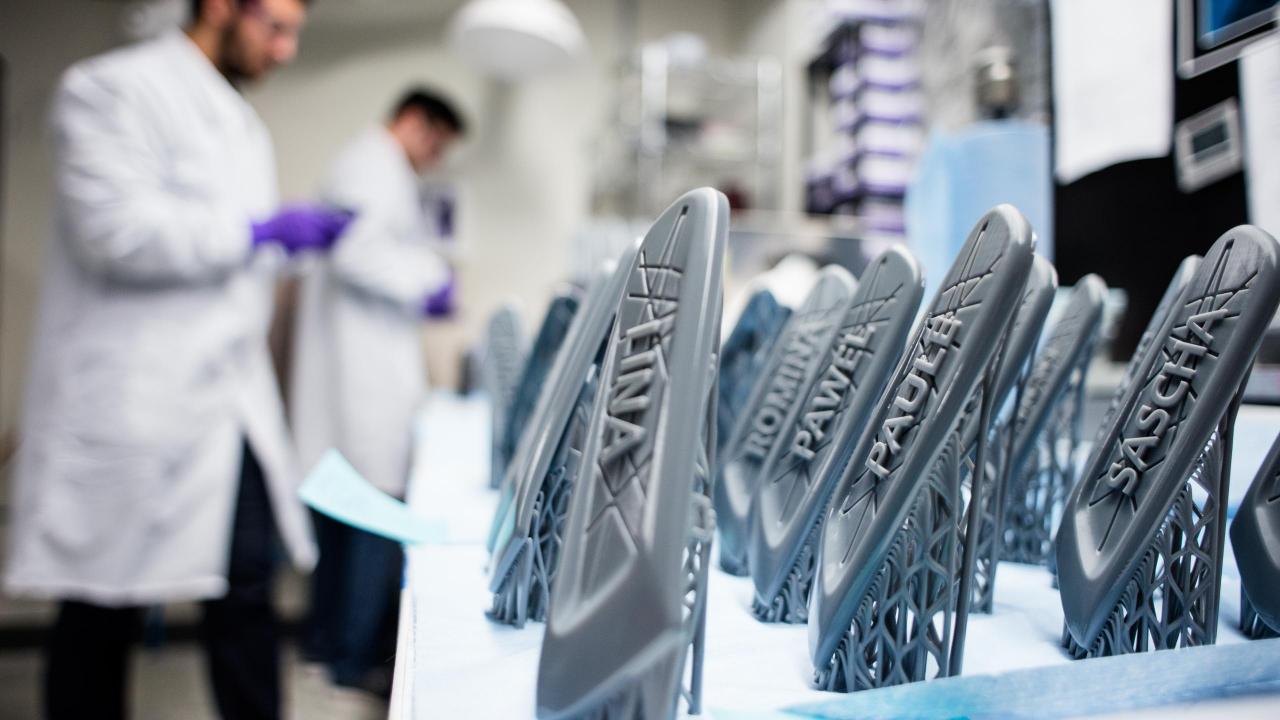May 25, 2016 Updated 5/25/2016
Email Print

Carbon3D Inc. A decorate side scuttle exterior trim part made using Carbon3D Inc.’s CLIP process.
A 3-D printing startup in Redwood City, Calif., is making inroads in the automotive market. Counting Ford Motor Co., BMW AG and Delphi Automotive among its early partners, Carbon3D Inc. recently released its first commercial printer.
The device, based on a printing technique called continuous liquid interface production, or CLIP, is designed to address performance gaps left by other 3-D printing methods.
CLIP uses a pool of UV-curable resin, into which a sequence of UV images is projected. A build platform continuously rises as the part solidifies from underneath. The light is projected through an oxygen-permeable window to maintain a thin layer of uncured resin (oxygen inhibits the polymerization reaction) and keep the part from sticking to the tray.
Carbon says parts produced with CLIP perform similarly to injection molded parts, and are isotropic, meaning the mechanical properties are the same no matter in which system the part is printed. The process takes a fraction of the time of traditional machines, and according to Carbon the technology overcomes structural and finish flaws seen with other methods.
“What we saw is there’s a tradeoff,” said Sasha Seletsky, Carbon’s strategic development manager. “With the light-based technologies you get great surface finish and resolution, and then with the heat-based technologies you get good mechanical properties, but you can’t have both. There’s no technology that gives you both great surface finish and great mechanical properties. And so we saw that as one of the key reasons why 3-D printing hasn’t really found production applications in automotive, and in other industries. Because engineers can’t accept that tradeoff between surface quality and resolution and mechanical properties; they need both.”
Carbon is currently working with automakers and tier suppliers to validate its materials, which were developed in-house and tuned to closely match the performance of commonly used thermoplastics.
“We thought that the easiest way for engineers to understand our materials and to brainstorm applications is for our materials to sound similar to materials that they’re familiar with,” Seletsky said.
The lineup includes a rigid polyurethane comparable to ABS, a flexible polyurethane comparable to polypropylene, and a cyanate ester-based resin that performs similarly to a 15-percent glass-filled nylon and is appropriate for high-temperature applications. Carbon is working to develop a greater variety of materials, and recently announced a joint development agreement with Kodak, which will develop materials in parallel with Carbon. Seletsky said he envisions a future app store-style resin market, with resins developed by third parties and validated by Carbon.

Carbon3D Inc. Seletsky
“Our material solutions space is really large, so I can see a future where we develop materials that have properties that are completely different from any thermoplastics that are out there,” he said.
At present, the build volume for CLIP parts is 81 millimeters by 144 mm by 330 mm. That’s not a large part, but according to Carbon’s analysis, about 40 percent of the plastic parts in a Volkswagen Golf or Ford Fusion are within the current build margins. A larger build volume is within future development plans.
In addition to prototyping, Carbon’s partners have already used CLIP to manufacture some lower-volume production parts.
Ford’s Transit Connect van has been fitted with bumper parts made using Carbon’s processes while Delphi is testing electric connector systems made with CLIP. BMW produced side scuttles, an exterior nameplate badge, with Carbon.
Ultimately, Carbon is interested in unlocking high-volume production applications.
CLIP is slower and more expensive than injection molding. But 3-D printing can solve certain manufacturing problems and allow for geometries of parts not possible with injection molding.
“Engineers for decades have designed parts with certain design rules in mind,” Seletsky said. “It takes the right engineer to think outside the box, to think about how they would approach something that’s very fundamental to their job, which is part design, how they would approach it differently if all of a sudden they have more design freedom.”
As automakers continue to work to reduce mass and consolidate parts, Carbon is counting on the value of that design flexibility.
“I can’t imagine the [photopolymer] materials will ever be cheaper on a dollar-per-kilogram basis, for our materials vs. traditionally used thermoplastics. If you keep the design constant, I don’t think we’ll be competitive with injection molding at volumes of hundreds of thousands and millions of units,” Seletsky said. “But if you think about design in a different way, and you use this new design freedom that you have to integrate parts, to reduce the complexity, to reduce the failure modes, to reduce pressure losses, reduce the section of the vehicle between interior and exterior, etc., then if you think about it on a system level or on a part level, then the economics will make sense.”
Beyond automotive, Carbon is exploring applications for CLIP in the aerospace and medical industries, and scored Johnson & Johnson as a partner in that market.




























